How to grow lemon at home in 7 easy steps!
Growing lemons at home is possible even if you don’t have a green thumb. So it is possible that excellent fragrant lemons will grow between the walls of your house and that even wonderfully fragrant flowers will grow in spring. Think how nice and healthy it would be to pick a juicy lemon without leaving the house and have it immediately available for juicing or other uses in the kitchen. Just follow a few small recommendations.
1) Plant a lemon seed
Choose a vase at least 30 cm deep. and fill it with fresh, nutrient-rich soil. Make a small hole four fingers below the surface and insert the lemon stone, then water gently and let it rest. After a month or a maximum of a month and a half, you will see the shoot emerging from the soil.
Let it grow to a height of 15 to 20 cm and then transfer it to a larger pot. Be careful not to do this procedure before winter, otherwise the plant, too young, could be affected by temperature variations.
2) Store the plant in the most suitable place
Do not leave the lemon tree on the balcony if your house is in an area where temperatures are too low. In this case, it is better to bring the plant inside or cover it with a protective cover or a small greenhouse. If you want to bring it inside, avoid areas near radiators. So choose a ventilated but not cold place. The ideal would be stairs, if available, or a small space near the window if there is no radiator nearby.
3) Fertilization
Like any living being, the lemon tree needs nutrition. This is essential in spring when the flowers and later the fruits arrive. Make sure that the lemon does not lack primary minerals such as nitrogen, potassium and phosphorus, but more rarely secondary minerals such as copper, zinc, iron, molybdenum and manganese. You can find suitable mixtures to add to the water in specialist shops. Even a light homemade compost, if available, can contribute to the healthy growth of the lemon tree.
4) Water regularly
A certain amount of caution is required here because you should not overdo it, but you should not leave the plant to its own devices either. Regular watering means just once a week in winter. From spring onwards, increase the frequency of watering the plant to every two to three days. In summer, it is necessary to keep the plant under control so that the soil is always moist. It is therefore advisable to carry out a quick check every day and add water if necessary.
5) Change the vase if necessary
The lemon tree grows and the diameter of the leafy plant exceeds several times the diameter of the pot. It is time to decant; Do this only in spring, because the roots can freeze in winter and dry out in summer. The most appropriate time interval is at first every two to three years, then every four years. Always choose terracotta pots and not plastic ones to allow the roots to breathe.
6) Prune the plant only when necessary
Nature is able to make any plant grow harmoniously, but it can happen that over time some branches weaken and dry out, or that the plant becomes too thick inside and does not let light and air in. In these cases, you can proceed with pruning, which is never too invasive and always delicate. If you have to cut a branch, do it at a node or bud, half an inch after the fork. However, if you really need to remove something, cut it at the beginning, but without touching the trunk. Use sharp scissors or perfectly clean loppers.
7) Pests
Even if the plant lives in the house or on the balcony, it can be attacked by pests, such as the fungus that dries out the branches and leaves. If you notice it, cut off the affected branches immediately. If you notice dark, rubbery spots on the bark, this is another type of fungus that spreads to the roots and causes them to rot. To intervene effectively, it is necessary to remove the entire affected part of the bark and then apply a preparation based on copper salts to the exposed parts.
The last and most common enemy is the cochineal. You can recognize it by the white formation that we see on the leaves, initially these are small white dots that then spread. As soon as you notice this, immediately clean each leaf with a cotton pad soaked in alcohol.
